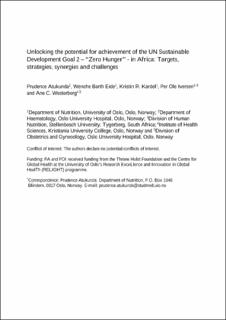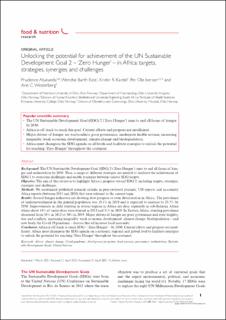| dc.contributor.author | Atukunda, Prudence | |
| dc.contributor.author | Eide, Wenche Barth | |
| dc.contributor.author | Kardel, Kristin Reimers | |
| dc.contributor.author | Iversen, Per Ole | |
| dc.contributor.author | Westerberg, Ane Cecilie | |
| dc.date.accessioned | 2022-07-15T07:31:12Z | |
| dc.date.available | 2022-07-15T07:31:12Z | |
| dc.date.created | 2021-05-02T08:36:15Z | |
| dc.date.issued | 2021 | |
| dc.identifier.citation | Food & Nutrition Research, 65. | en_US |
| dc.identifier.issn | 1654-6628 | |
| dc.identifier.uri | https://hdl.handle.net/11250/3005655 | |
| dc.description.abstract | Background: The UN Sustainable Development Goal (SDG) 2 (‘Zero Hunger’) aims to end all forms of hunger and malnutrition by 2030. Thus, a range of different strategies are needed to facilitate the achievement of SDG 2 to overcome challenges and enable synergies between various SDG targets.
Objective: The aim of this review is to highlight Africa’s progress toward SDG 2, including targets, strategies, synergies and challenges.
Methods: We scrutinized published research articles in peer-reviewed journals, UN reports and in-country Africa reports (between 2015 and 2020) that were relevant to the current topic.
Results: Several hunger indicators are showing slow progress or even deterioration in Africa. The prevalence of undernourishment in the general population was 19.1% in 2019 and is expected to increase to 25.7% by 2030. Improvements in child stunting in several regions in Africa are slow, especially in sub-Saharan Africa where about 34% of under-fives were stunted in 2012 and 31% in 2019. In Eastern Africa, stunting prevalence decreased from 38% in 2012 to 34% in 2019. Major drivers of hunger are poor governance and state fragility, war and conflicts, increasing inequality, weak economic development, climate change, biodegradation – and now lately the Covid 19 pandemic – factors that all increase food insecurity.
Conclusion: Africa is off track to reach SDG – ‘Zero Hunger’ – by 2030. Current efforts and progress are insufficient. Africa must champion the SDG agenda on a national, regional and global level to facilitate synergies to unlock the potential for reaching ‘Zero Hunger’ throughout the continent. | en_US |
| dc.language.iso | eng | en_US |
| dc.rights | Navngivelse 4.0 Internasjonal | * |
| dc.rights.uri | http://creativecommons.org/licenses/by/4.0/deed.no | * |
| dc.title | Unlocking the potential for achievement of the UN Sustainable Development Goal 2 – “Zero Hunger” - in Africa: Targets, strategies, synergies and challenges | en_US |
| dc.type | Peer reviewed | en_US |
| dc.type | Journal article | en_US |
| dc.description.version | publishedVersion | en_US |
| dc.source.pagenumber | 11. | en_US |
| dc.source.volume | 65 | en_US |
| dc.source.journal | Food & Nutrition Research | en_US |
| dc.identifier.doi | 10.29219/fnr.v65.7686 | |
| dc.identifier.cristin | 1907625 | |
| dc.source.articlenumber | 7686 | en_US |
| cristin.ispublished | false | |
| cristin.fulltext | postprint | |
| cristin.fulltext | postprint | |
| cristin.qualitycode | 1 | |


